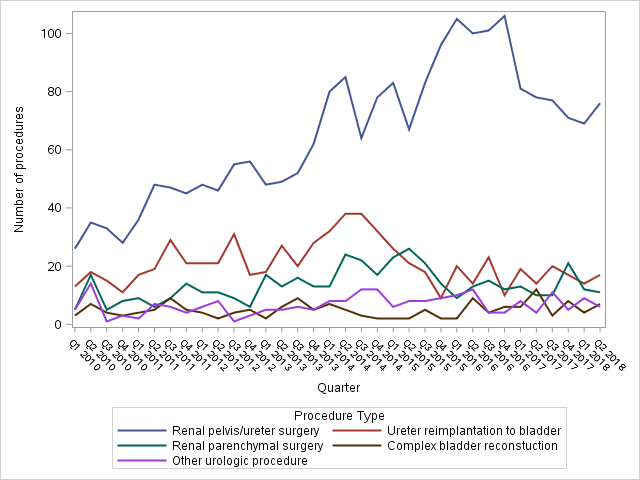Robotic assist technology utilization for urologic surgery across a nationwide sample of tertiary pediatric hospitals
Daryl J. McLeod, MD MPH, Alexandra Rehfuss, MD, Marc Michalsky, MD, Karen Diefenbach, MD, Jennifer Cooper, PhD.
Nationwide Children's Hospital, Columbus, OH, USA.
BACKGROUND: Over the last decade, access to robotic assist technology has substantially increased at tertiary children's hospitals. Early evidence suggests a corresponding increase in robotic case utilization in pediatric urology, however an evaluation of national trends and specific drivers of these trends has not yet been performed.
METHODS: We used the Pediatric Health Information System (PHIS) to identify patients who underwent inpatient or outpatient robotic urologic surgery across 27 tertiary children's hospitals between January 2010 and June 2018. Cases were grouped into the following categories: renal pelvis/ureter, ureter reimplantation to bladder, renal parenchymal surgery, complex bladder reconstruction and other urologic procedures. We examined trends over time in the total number of urologic surgeries performed, the number of surgeries performed in each procedure category, and the number of individual surgeons performing cases.
RESULTS: In total 3,768 urologic robotic surgery cases were identified across 20 of the 27 included hospitals. Across all hospitals during the study period, the number of urologic robotic surgeries performed increased by 2.9% per quarter (P<0.001). The number of attending surgeons performing urologic robotic procedures over the same period increased similarly at 3.0% per quarter (P<0.001). Renal pelvis/ureter surgery represented the most common type of procedure performed (58.8%), and these procedures increased the most over time (3.3% per quarter, 95% CI 2.5-4.0). Renal parenchymal surgery showed a smaller but statistically significant increase over the same time period (1.6% per quarter, 95% CI 0.2-3.0), but trends in other types of procedures were not significant (Figure).
CONCLUSIONS: Over the study period, we identified a positive trend in overall utilization of robotic technology for pediatric urologic surgery. We also identified a similar trend in the number of individual attending surgeons performing these surgeries, indicating that increasing numbers of pediatric urologists are training on this technology. After stratifying by case type, we found that renal pelvis/ureter surgery appeared to drive the overall increase in robotic utilization over the study period. Despite increasing evidence in the literature for the feasibility of the robotic approach to ureter reimplantation to bladder and complex bladder reconstruction, no increase in utilization of the robot for this type of procedure was identified. 
Back to 2019 Abstracts




